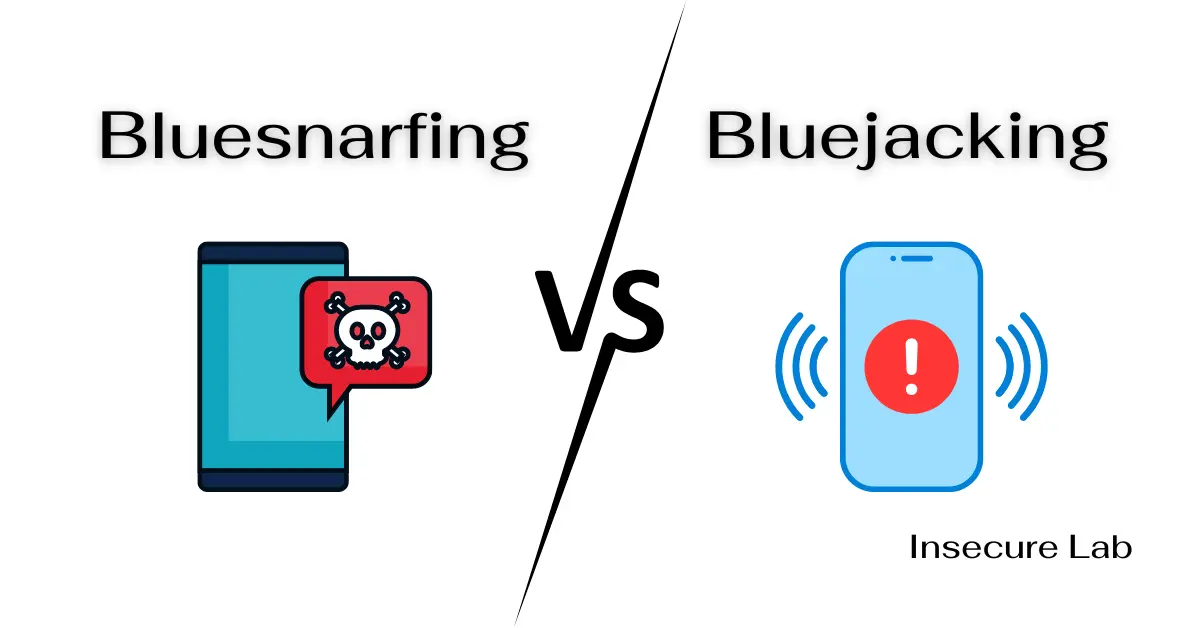In this comprehensive comparison of Bluesnarfing vs Bluejacking attacks we will explore the key differences between them on various aspects of cyber security.
Bluesnarfing and Bluejacking
Bluetooth has become an integral part of our daily lives, enabling seamless connections between devices. However, with the convenience provided by Bluetooth, also comes the potential for security vulnerabilities. Two such vulnerabilities are Bluesnarfing and Bluejacking.
These two terms describe different types of attacks (Bluetooth hacking techniques) that exploit Bluetooth-enabled devices, but they differ significantly in their nature, purpose, and potential consequences.
Bluesnarfing
Bluesnarfing refers to the unauthorized access and theft of data from Bluetooth-enabled devices, such as smartphones, laptops, and tablets. Attackers exploit vulnerabilities in Bluetooth security protocols to gain unauthorized access to the target device’s data, including contacts, emails, text messages, and other sensitive information. The term “Bluesnarfing” is derived from “blue,” which signifies Bluetooth technology, and “snarfing,” which means to consume or grab.
Example: Bluesnarfing Attack
At a busy coffee shop, a hacker uses specialized software to connect to a patron’s Bluetooth-enabled smartphone that is set to discoverable mode. Exploiting a security vulnerability, the hacker silently accesses and downloads the victim’s personal data, including contacts and text messages, without the phone owner’s knowledge.
Bluejacking
Bluejacking, on the other hand, is a much milder form of attack that involves sending unsolicited messages or spam to Bluetooth-enabled devices. Attackers use the device’s capability to receive Bluetooth connection requests and exploit this feature to send short messages or advertisements to nearby devices. Unlike Bluesnarfing, Bluejacking doesn’t directly compromise data or access sensitive information. Instead, it focuses on annoying or amusing the recipients.
Example: Bluejacking Attack
In a crowded subway, an individual uses their phone to scan for nearby Bluetooth-enabled devices and sends an unsolicited, anonymous message to several commuters, promoting a website. The recipients, surprised to receive a message from an unknown source, are victims of a harmless but intrusive bluejacking prank.
Bluesnarfing vs Bluejacking
Let’s compare Bluesnarfing and Bluejacking attacks in detail:
Difference Between Bluesnarfing and Bluejacking
This table provides an overview of the key differences between Bluesnarfing and Bluejacking attacks on various aspects.
| Aspect | Bluesnarfing | Bluejacking |
|---|---|---|
| Definition | Unauthorized access and theft of data from a Bluetooth-enabled device, often without the user’s knowledge or consent. | Sending unsolicited messages or vCards to nearby Bluetooth-enabled devices to display messages on their screens. |
| Data Target | Extracts sensitive data such as contacts, emails, messages, and other personal information. | Involves sending simple text messages or virtual business cards (vCards) containing a message. |
| Purpose | Malicious intent, typically for identity theft or unauthorized access. | Prank or annoyance with no direct data theft motive. |
| Permission | Requires exploitation of Bluetooth vulnerabilities and security weaknesses. | Exploits the device’s willingness to accept incoming Bluetooth connections. |
| User Awareness | Often occurs without the user’s knowledge due to its covert nature. | User may notice unauthorized message or vCard appearing on their device. |
| Data Access | Gains unauthorized access to sensitive data stored on the target device. | Limited to the ability to send messages or vCards; doesn’t access data directly. |
| Level of Threat | High, as it involves data theft and potential for serious privacy breaches. | Low, as it primarily aims to annoy or surprise users rather than steal data. |
| Legal Implications | Considered illegal in many jurisdictions due to its malicious intent and data theft. | Generally falls in the gray area of legality. Laws vary depending on the context. |
| Prevention | Regularly update device firmware and software, disable unnecessary Bluetooth services, and avoid pairing in public places. | Disable Bluetooth when not in use, avoid accepting connections from unknown devices. |
| Mitigation | Implement security protocols and use strong authentication mechanisms for Bluetooth devices. | Be cautious about opening messages from unknown sources and avoid auto-pairing. |
| Real-life Impact | Instances of data breaches and personal information exposure leading to identity theft. | Mostly causes confusion, surprise, and brief inconvenience for users. |
| Examples | – The 2003 Nokia 6310i Bluetooth vulnerability allowed attackers to remotely copy the phone’s contact book. – The 2004 incident where Paris Hilton’s phone was Bluesnarfed, resulting in private content leakage. | – Sending humorous messages to nearby devices in crowded places. – Displaying messages like “You’ve been Bluejacked!” on strangers’ devices. |
Conclusion
Both Bluesnarfing and Bluejacking are security vulnerabilities associated with Bluetooth technology, but they differ in their intent, impact, and methods.
Bluesnarfing is a serious threat that involves unauthorized access and data theft from Bluetooth-enabled devices. On the other hand, Bluejacking is more of a harmless prank, involving the sending of unsolicited messages or vCards to nearby devices.
It’s essential for users to remain vigilant, keep their devices updated, and adopt security best practices to mitigate the risks posed by these vulnerabilities and ensure the safety of their personal data.

